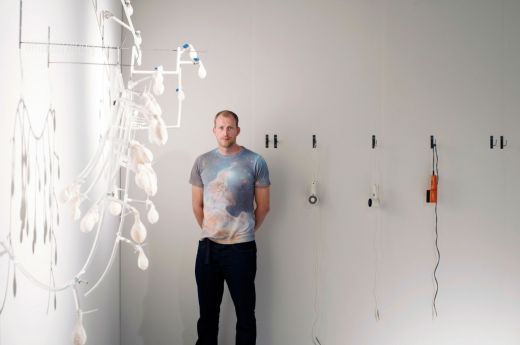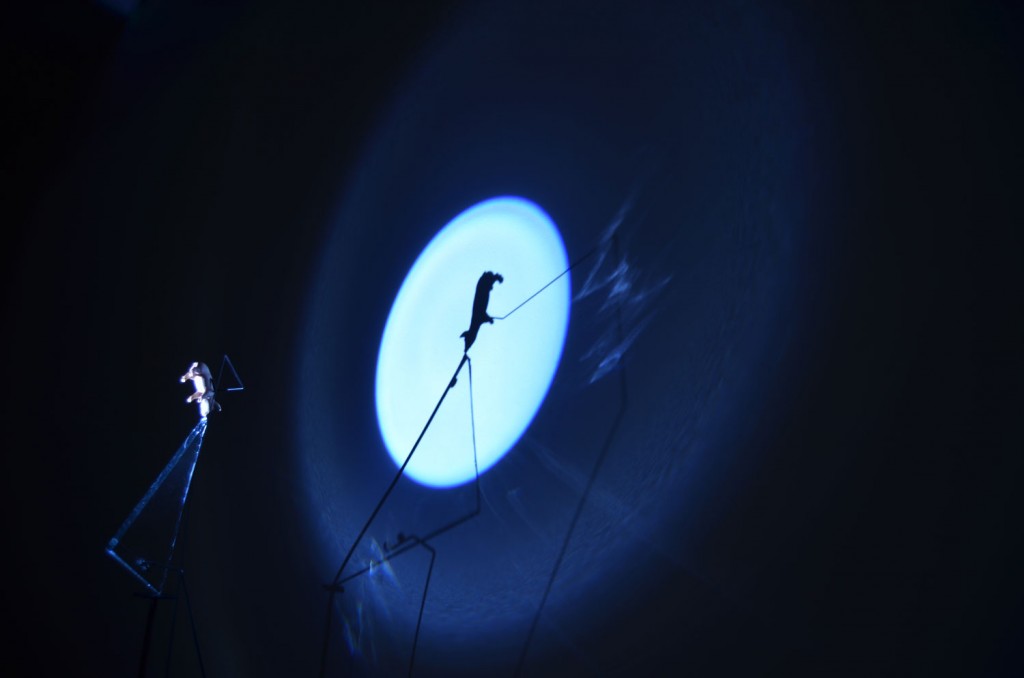TOM FOULSHAM: A KISS IS (not) JUST A KISS
Alexandra Cunningham

Portrait of Tom Foulsham. Photo courtesy James Harris.
Tom Foulsham hyped his work like a cultured carny barker, “Be the balance. Blow yourself ‘round.” And unlike most unsolicited invitations during Basel fair week, his was delightedly accepted.
The visitors to Design Miami/ Basel 2012 seemed never to tire of examining Foulsham’s playful, interactive sculpture, “Blow Go Round” (2012), a see-saw-like contraption on which two volunteers must balance and propel themselves in a circle by blowing emphatically, or by using the wind-force of everyday electronics such as hair dryers and fans. Foulsham spent the duration of his time untangling several vintage Braun HLD-5s and responding to an overflow of inquiries regarding the meaning of his work: a curious mixture of physics and design for a fair for collectible furniture, lighting, and objets d’art.
With no apparent function aside from facilitating a good time, “Go Round” became the go-to for Swiss TV stations, wayward journalists, and curious collectors. Those terrified by the idea of mounting the shaky steel saddles became amused by the happy shrieks of their companions as they moved in circles with unexpected sources of energy—their breath, or the slim wheeze of air generated by the Brauns. It didn’t seem possible that these passive actors could produce such momentum, but they did.
The six foot five inch tall designer from Hackney, England has developed a reputation for engineering structures that demonstrate complex phenomena through simple gestures, choreographing moments for his viewers to see what is otherwise invisible. Having studied architecture at Bartlett UCL and holding an MA in Design Products from the Royal College of Art, Foulsham is more Steiner than Schindler, his research inspired by quantum mechanics, contemporary dance, and science fiction.
He has worked in the studios of contemporary design heavyweights Ron Arad and Thomas Heatherwick, collaborated with visual artists such as Laurie Anderson, Trisha Brown, and Gordon Matta-Clark. In 2011, the Marsden Woo Gallery in London mounted a solo exhibition of his work, the inception of Basel’s “Go Round,” which included “Liberator Dryer” (2011), a churning clothes dryer counterbalanced precariously with various found objects, and “Simon” (2011), a toy pig balancing his lips on the edge of a shard of glass. Many visitors to the Woo show assumed the components of each work were fixed, the danger of suspending heavy appliances in public spaces with negligible support structures too greatly challenging conventional standards of safety.

Tom Foulsham, “Simon,” 2011. Toy pig, glass. Photo courtesy of Tom Foulsham.
In his 1975 memoir, The Periodic Table, Levi explains events from his life through a collection of molecular biographies, each named after one of 21 chemical elements. “Hydrogen” tells of his childhood attraction to science and subsequent experimentations. “Gold” relays the events surrounding his arrest and imprisonment in the Auschwitz concentration camp. Each element-as-protagonist personifies characteristics of the author’s layered journey, and Levi reveals seemingly incomprehensible experiences through the lyrical narratives of his chemical metaphors. He opens his readers to a world of foreign encounters, each illustrated by the abstract yet familiar rhetoric of grade school science class.
Similar to how The Periodic Table’s elements give shape to experiences for which “every verbal description must be inadequate,” Foulsham retools everyday objects into elevated works that remind us that our actions have repercussions.
For example, “Blow Go Round” magnifies the significance of our breathing as an energy source that can propel 350 pounds of flesh in a circle. This piece was inspired by puffs of breath, which imperceptibly push our heads back when we speak. People are largely unconscious of the movement caused by our breath. Foulsham’s work asks, what other actions create a force that we don’t recognize, and what is the effect of that action?
Foulsham intends to recalibrate the highway hypnosis of our everyday lives. Upon first encounter, his designs seem quixotic and even naïve: a giraffe balancing on a whale with the tip of his tongue, a smock of inflating and deflating balloons. However, the effect on his unsuspecting user is transformative. As Foulsham slyly draws one in through accessible subject matter, his grander point hits home. As Levi’s parables conjure familiar images of human discovery, suffering, joy and release, Foulsham’s work instigates understanding of how a small gesture can create profound consequences.










